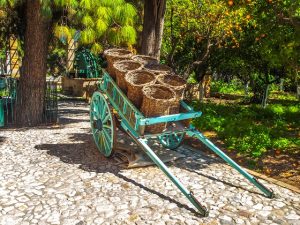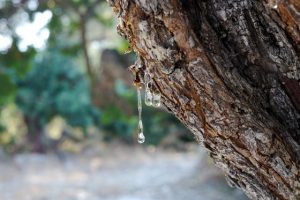Much as Chios is famous for its mastic, it is not the only “magic” one can find on this island. Alongside its rich history starting from the Neolithic Age and including adventures with Saracene pirates and the Turks during the Greek Revolution, Chios also claims to be the birthplace of Homer. It was certainly the birthplace of eminent Greek politicians and writers such as Adamantios Korais, Emmanouil Roidis and Alexandre Mavrokordatos.

Discover the town of Chios
Built on the east coast of Greek island facing Ionia, a region of Asia Minor, the town is proof of the maritime glory and aristocratic nature of the island.
Join us for:
• Some shopping at the “Aplotaria” market, which specializes in local products
• A walk around Vounakio square and a visit to one of its cafes
• A stroll in the Municipal Park
• A visit to the eleven-century old Castle dominating the port, in which there is the tomb of Kara Ali, the Egyptian admiral who ordered the massacre at Chios in 1822.

Definitely worth visiting are:
• The Byzantine Museum, housed in an old Ottoman mosque, where you can see a perfect copy of the famous Delacroix’s painting “Massacre at Chios”, and
• The famous “Korais” library with the personal collection of Adamantios Korais among its 1,300 historical volumes.
Call in at the Naval Museum and see accurate replicas of sailing ships and steamboats. Walk through the picturesque narrow streets of Kaloplitis and marvel at the ship owners’ mansions, and go all the way on to Tampákika, where you can see the majestic mills of the old tanneries and Ioustiniani Palace.

The most famous local product is mastic.
Known throughout the world, mastic is an appellation d’origine contrôlée (= controlled designation of origin) product growing only in the South of Chios, where it has been raised since the 8th-7th century A.D. This natural product is cultivated entirely by hand and is nowadays used in medicine, pharmacy, dentistry and cosmetics. At the central market of the town of Chios, you can buy mastic-based jams and sweets, brandies and, of course, local delicious ouzo!
Chios, part of the Northeastern Aegean island complex, is home to 53,000 people today. Explore the places where these people build their day-to-day lives: either in medieval settlements where Genoa and Chios meet, or in beautiful small towns by the sea, and participate in religious festivities where the locals make their own colourful history, such as the explosive Easter Saturday night in Vrontados.

Enjoy the beauty of the island as you walk through:
• Kampos:
Just 6 km from the town of Chios is the traditional settlement of Kampos, founded by the Genoese invaders in the 14th century and currently under the protection of the Ministry of Culture and Tourism. Genoa and Chios meet stylishly in the earth-coloured mansions of the local aristocrats of the past. Don’t let the high walls stop you exploring vast orange orchards, tree-roofed alleys and scented gardens. Devastated by the massacre in 1822 and the earthquake in 1881, the old mansions with their enormous gates, coats of arms, and arched windows have been revamped and turned into guest houses, awakening memories of their glory days of the 17th and 18th centuries. Experience the atmosphere of a bygone age as you stroll or cycle around the settlement’s mansions and forty churches.
• Nea Moni:
11km south of the town of Chios lies the most important religious site of the island. Built in the 11th century, Nea Moni (= New Monastery) is one of the most important Byzantine monuments in Greece, and is also a UNESCO world heritage site. Some of the most significant mosaics in the Mediterranean as well as a museum are housed here.
• Anavatos and Avgogyma
Further to the South is another marvel, “the Mystras of the Aegean Sea”, the ruined byzantine village of Anavatos. Note the unique architecture of the place and stroll through the remains of Byzantine history and the ghosts of the martyrs of the massacre of Chios. Quench your thirst with a local drink under the plane trees in the traditional village of Avgogyma afterwards.
• The medieval mastic villages
In the south and most fertile part of the island in the only place in the world where mastic grows, there are the 24 mastic villages. Built in the Middle Ages, these villages display exquisite architecture and unique decorative elements, such as the ksistá, “scratched surfaces”, on the facades of the houses in Pyrgi, the biggest of the villages. Ksista are geometric designs scratched on plaster with a technique that is unparalleled in the world. If you are lucky enough, you might catch the plaster workers at work!
South of Pyrgi, there is Mestá, another medieval village, whose stone houses form an impregnable fortress. The village has only one gateway for people to enter and the houses are built so close to one another that locals say the only way to walk around is by climbing over the roofs. Let the locals treat you with “mestoutsiko”, a local wine, and with a drink made of distilled figs and grapes, “souma”.

Chios BeachesNo one who loves the sea could ever leave Chios dissatisfied. You don’t want to go far from the town? The beaches of Ormos tou Lo (=Lo’s Bay) and Tagma are at your disposal. Are you into sea sports? Bella Vista and Afanis Naftis (=Unknown Sailor) are perfect for wind surfing.
Do you want to combine legend with pleasure? Swim at the beach of Daskalopetra, where Homer was supposed to sit on a stone and teach. “Daskalopetra” actually means “teaching stone”.
• If you like white pebbles, the endless beach of Yossonas, the Bay of Nágos and the crystal waters of Yaliskári await you a short distance from Kardamylla.
• Mavra Volia is the only beach with black sand on the island. Go there to enjoy the magic of the volcanic scenery and the taste of fresh fish at the tavernas by the beach.
• For lovers of fine white sand, the cosmopolitan beach of Komi in the south of the island is a must.
• For families there is Karfas, 5 km from Kampos.
• If your ideal beach has crystal waters and white sand, then Elinta, in the Northeast, will blow your mind!
• If you fancy beach bars, enjoy yourselves in Limnia and Managros, a 40,000-square-metre beach.
• For the young of all ages, Agia Fotia (=Sacred Fire) and Paralia ton Glaron (=Seagulls’ beach), with their turquoise waters and thick sand, host DJ sets.
Getting there:
Get to Chios by plane from Athens and Thessaloniki and by boat from Piraeus, Thessaloniki, Kavala, Rhodes, Samos, Lemnos and Mytilene.
From Chios you can take a boat to Oinousses and Psara, and there is also a daily service to Cesme in Turkey.
For further information: www.chios.gr
Source: visitgreece
Ask me anything
Explore related questions





